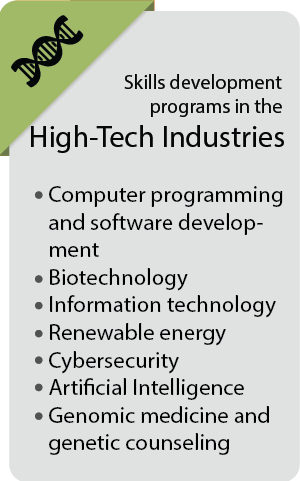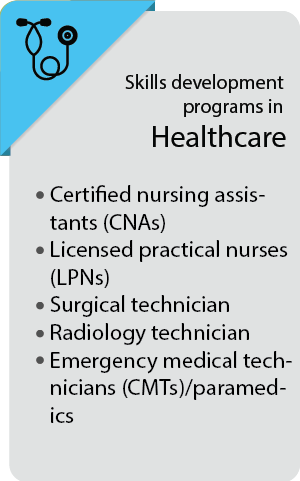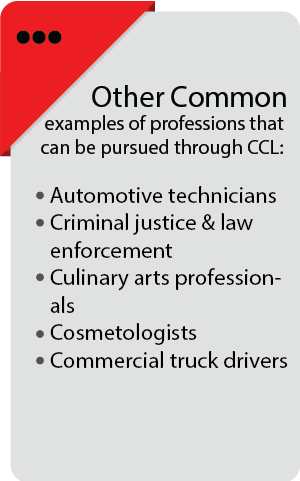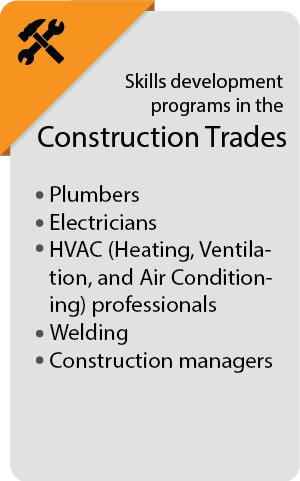At the most general level, those who support workforce education argue it is an increasingly attractive way to prepare Americans for meaningful and financially rewarding careers. They suggest greater federal support is warranted because of the benefits to the individuals who enroll in the programs, to businesses, and to the nation generally.
The Case for Greater Federal Support
Benefits to Graduates
Supporters argue three important benefits for those who graduate from these programs justify increased federal support.
First, they argue that research shows skills education increases graduates’ earnings. Proponents cite a range of studies finding those who attain a certificate from a program that prepares students for a given occupation have higher rates of employment and earn roughly 10% more than those with only a high school diploma. Advocates further cite studies showing graduates themselves see their career education program as more personally and financially rewarding. (See “What the Evidence Says” below)
Second, supporters suggest workforce development is an increasingly important alternative given significant increases in the cost of college. From 1980 to 2020, the average cost per year of full-time enrollment in an undergraduate program (including tuition, fees, and room and board) grew from an inflation adjusted $10,231 to $28,775, an increase of 181%. While the costs of CCL programs can vary widely, proponents note, they typically cost between $5,000 and $15,000, making them much less expensive than college.
As the costs of college have increased, student loan debt has risen to become the second largest form of consumer borrowing in the US, trailing only home mortgage debt. In 1980, the graduating class owed an average of $12,831, adjusted for inflation. The class of 2021 averaged $31,100 in student loan debt, down from a peak of $34,398 in 2012 but still nearly 2.5 times the 1980 number.
Third, proponents argue that, in addition to costing less in terms of dollars, workforce development is also an attractive alternative because it takes much less time. Millions of Americans—including those fresh out of high school and older workers in low paying jobs—urgently need to get into higher paying and more meaningful careers. Supporters argue completing an expensive college degree simply isn’t feasible for those who can’t afford to give up work for four years. They suggest it’s appropriate to give these Americans options that are both shorter and lead more directly to higher paying jobs. Advocates argue once these workers have stabilized their financial situation, they may be in a position to seek additional credentials and education.
Benefits to Businesses
Proponents argue employers benefit significantly from CCL programs. Particularly with today’s worker shortages, the main benefit for business is a pipeline of skilled and productive employees. The United States now has 8.8 million job openings, but only 6.4 million unemployed workers.
Supporters note a growing number of employers are prioritizing skills over degrees attained. They point to an Advance CTE report that found 92% of surveyed employers were in favor of increased public funding for career and technical education.
Benefits to the Nation
Finally, proponents argue that greater federal support for CCL will generate four important benefits for the nation. First, they suggest it would create more jobs and boost economic prosperity even beyond those who graduate from these programs. Democrats are more optimistic than Republicans about an active federal role in improving the prosperity of individuals and families. Still, conservative and liberal economists agree that increasing individual productivity is one of the most fundamental drivers of a growing economy. When we produce more with the same investment of time and money, the economy grows, new jobs are created, and everyone prospers. Economists agree that a core reason the United States is the leading economy in the world is because its workers are some of the most productive.
Since the GI Bill, bipartisan agreement on the economic wisdom of investing in Americans’ productivity has been the foundation for significant federal support for college education. Supporters argue that workforce development programs can be a similarly sound investment in improving the nation’s productivity. In fact, many argue that the return on investment for career-connected learning is often even better than for college. On one side of the economic return equation, skills development programs are much shorter and less expensive for the student. On the other side of the equation, proponents suggest that these programs can still lead to substantial increases in earnings and productivity, particularly since they are so directly focused on preparing individuals for the work they will do and in industries where demand for workers is high.
Supporters argue that CCL’s boost to American prosperity is likely to be even greater going forward because it addresses the pronounced worker shortages mentioned above that the country currently faces. The lack of workers in many fields across the country, proponents argue, is acting like a brake on the American economy. They suggest that the economic returns for greater productivity will be even greater in the near term because workforce development helps place workers in areas with critical shortages of individuals with the required skills.
Supporters argue that a second benefit to the nation would be higher tax revenues and decreased social spending. These net economic benefits for everyone, proponents suggest, are the natural consequence of the increased productivity and earnings, as well as decreased unemployment, that result from workforce education. For example, supporters cite a City and Guilds Group research review that reported that for every dollar invested in career and technical education, the state of Washington received an additional $9, and Tennessee an additional $5, in increased revenues. Over a 36-year period, the review further reported, the cumulative effect of savings on social spending and increased tax revenue was $25,000 per student completing a career and technical education course.
A clear majority of Americans (61%) agree there is too much inequality in the United States. Still, Republicans and Democrats often disagree about the best ways to address it. Many Democrats believe we should increase taxes on the wealthy to fund more social spending for those in need. Many Republicans argue policies that take money from those who have succeeded through their own merit to provide benefits to those who may not have been as hard working is unfair. More importantly, Republicans argue, redistributive tax policies don’t address the root problems. In fact, conservatives contend, income redistribution policies create incentives at odds with what works for long-term individual and national prosperity.
Many Republicans and Democrats agree, however, that bolstering CCL is a wise option that rises above the long-standing partisan divide over income redistribution policies. They argue that by completing skills education programs, workers can generate greater income for themselves while also taking well-earned satisfaction from making more meaningful contributions to society. In fact, supporters argue federal policy that focuses disproportionately on support for college education to the neglect of workforce development contributes to income inequality. They suggest that simply by supporting skills education proportionately to its worth we can provide more Americans with opportunities for upward economic mobility through their own merit.
Some argue investing in career development is wiser policy than forgiving the student loans of those with four-year and graduate degrees. They point to evidence confirming that those with college and graduate degrees have higher earning power than those without those degrees, putting most in a reasonable position to repay the loans as they agreed to do. Critics of the program argue subsidizing those with higher earning power by forgiving student loans increases income inequality. To qualify under the Biden Administration’s student loan forgiveness plan that was blocked by the Supreme Court, individuals must earn less than $125,000 and married couples less than $250,000.
Proponents further argue that CCL is particularly well suited to the challenges of income inequality unique to the United States. Among developed nations, the US has one of the highest levels of income inequality as well as one of the lowest levels of investment in career development programs.
The causal connection between the two, supporters argue, is growing. The rise of new technologies in a global marketplace has created higher demand for skilled labor, and those positions come with higher wages. Supporters argue these realities of the high-tech, global economy make skills development an increasingly timely and effective means of addressing rising income inequality in the US.
Federal Support for Education and
Training After High School
Supporters argue the fourth benefit of greater workforce development support is it will lead to better recognition of the important roles these careers play in our national life. Proponents from across the partisan divide argue that for too long federal policy has emphasized college to the exclusion of the many other important training opportunities that do not require a college degree. They observe that, in the eighty years since the passage of support for college education in the GI Bill, we’ve never gotten above 40% of Americans obtaining four-year degrees. Yet, the federal government provides over $112 billion per year in on-going funding for grants, work-study, and loans for college students. In contrast, proponents observe, the federal government provides less than $7 billion per year in on-going funding for workforce development and skills education, including $5.3 billion through the Workforce Innovation and Opportunity Act (WIOA) and $1.4 billion through the Strengthening Career and Technical Education Act for the 21st Century (Perkins V).
Advocates note that going to college is also privileged within our K-12 system. They suggest this results in many high school graduates for whom college was not a good fit wasting time and money in college, often without finishing but still burdened with student loan debt. Instead, supporters argue, these high school graduates could have been pursuing another career through skills education programs that would have helped them secure well paying jobs sooner for much less time and money.
Proponents suggest it’s high time we as a nation give the respect due to the majority of Americans who don’t get a degree but who make important contributions to our country. They suggest greater respect starts as a matter of federal policy, one that includes increased support for educational programs that focus directly on preparing these Americans for their careers.






